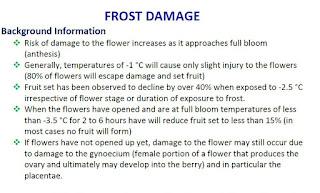WBPANS circulated a factsheet via e-mail from Dr. David Percival yesterday which can help ID frost damage. Dr. Percival also circulated this factsheet at the twilight meetings last week. Here are some screen shots of that factsheet. I will try and get the full factsheet posted later today.
If you are still seeing significant amount of white flowers in your field and bees are still active in the field, that is a good sign. Protecting against further disease may be prudent in these fields.
Note: the weather forecast is for another frost event across the Maritimes tonight!
For fields that have moderate damage, it would be worth your time to look closely at those fields, determine pollinator activity. Also cut open some flowers to see if the base of the flower (ovaries) are black. If the temperature was cold enough for long enough, the pollinated flowers could have been damaged as well. This is what happened in 1996 when we had a major frost event near the end of bloom.
I will be looking at fields today and will report tomorrow.
If you have crop insurance and you think you have damage, please call the Nova Scotia Crop and Livestock Insurance Commission ASAP to report damage to your fields!!


